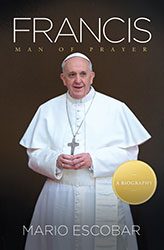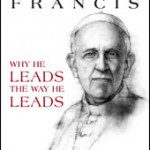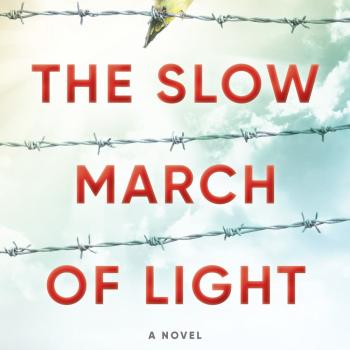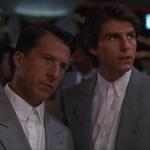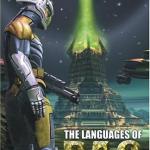A review of Francis: Man of Prayer, by Mario Escobar. Nashville: Thomas Nelson, 2013.
First of all, disregard the gold medallion the marketers stuck on the cover of this book: “A Biography.” It’s not, or at least, not really. A true biography involves some amount of original research, whether in library archives or on-the-ground interviews with people who know the subject firsthand. Sometimes a biography even includes fresh interviews with the subject himself. It should at least include something beyond the sifting of already published and readily available sources. But that’s okay, Mario Escobar’s Francis: Man of Prayer is still a fine book. While we are all trying to figure out who Pope Francis is, Escobar does a good job of leading us to him.
As with the dozen other “Lives” of Pope Francis that have made it quickly to market over the last two months, Francis: Man of Prayer is a synthesis of the events and pivotal moments in the life of the new pope, as well as a look at how Francis’s ascension to St. Peter’s Chair can be plotted on the trajectory of the Roman Catholic Church from the reforms instituted at the Second Vatican Council (1962-65), to the present.
Escobar writes in Spanish, and Francis was published simultaneously in Spanish and English, by sister companies Thomas Nelson in the States, and Grupo Nelson in Rio de Janeiro. You would never know, however, that the book was translated. The narrative is swift, and the plot propels forward. Curiously, though, the book’s Spanish title wasn’t translated word-for-word for the English edition. Had it been, our title would be Francis: The First Latin American Pope. It is puzzling to me that Nelson, here, omitted “Pope” from their title. Isn’t that sort of the point? No one outside of Argentina was writing about Cardinal Bergoglio six months ago.
Now, Cardinal Bergoglio cum Pope Francis is blowing a daily dose of fresh air into Christendom. Even the most important monthly magazine for Christian evangelicals, Christianity Today, published a page in their June 2013 issue praising his early efforts. Pope Francis is, in fact, threatening to dismantle the power structure, clericalism, obfuscation, and secrecy that have been hallmarks of the papacy and its curia for as long as anyone can remember. Many Catholics, as well as those on the outside looking in, are hopeful beyond imagining. So there are plenty of good reasons why people are buying and reading books such as Escobar’s.
As he tells a good story, Escobar seems to guess, at times, what the Pope is thinking or feeling. This can be a dangerous game. “He felt…” and “He began to worry…” are the sorts of statements we often encounter, and usually in contexts where the author couldn’t possibly know for sure. Nevertheless, I appreciated his instincts, and to me, they usually rang true.
Occasionally, Escobar seems to try too hard to “set up” dramatic situations, for instance, depicting the quiet desperation into which Pope Francis recently walked and saved the day. For instance, under a heading, “Francis, Pope of Reforms,” Escobar begins by explaining that, despite his charisma, Pope John Paul II “did not bring about any significant change or reform in the practices or heart of the Catholic Church.” Hmmm. That can’t be right. JPII actually brought deep and lasting change in many ways, including how the Church relates to Jews and Judaism, how Catholics pray the rosary (adding five new “mysteries,” altering a practice that goes back more than a millennium), and by turning the role of Holy Father into something akin to a traveling evangelist for the Church and its causes. If Escobar wanted to “set up” the fact that Pope Francis was walking into a Church in need, he might have emphasized the less charismatic Pope Benedict XVI, and his shocking abdication, with more piquancy.
Some readers are turning to multiple books about the new Pope in their enthusiasm to know him. Each has its own nuance and emphases; this one, for instance, takes a distinctively spiritual tact when analyzing Bergoglio’s ministry during the Argentinian Dirty War. “Did Bergoglio do enough? We could also ask ourselves, what would we have done if it meant risking our lives?” writes the author, whereas others would find such a question completely beside the point.
Well chosen quotations demonstrate Francis’s passions, as when, in 2009 he said to a large gathering of Catholic relief and development employees and volunteers: “Years ago, to our great shame, we attended luxurious dinners…where jewelry and other ostentatious luxuries were raffled off…. [T]hat [was] not [us].” And then, just a year ago, in a homily delivered in Buenos Aires he remarked, “These are the hypocrites of today: those who ‘clericalize’ the church, those who draw the people of God away from salvation.” Did the cardinals who selected him know what a reformer Bergoglio would be?
That’s the good news: Yes, they seem to have known. While he has his detractors, including many who are working in the Vatican but have been silent up until now, Pope Francis also has the good will of hundreds of millions of Catholics. And he has the quiet but emboldening support of many cardinals and bishops who want to change the culture and message of St. Peter’s Church.
 Jon M. Sweeney is the author of The Pope Who Quit: A True Medieval Tale of Mystery, Death, and Salvation, recently optioned by HBO, and the co-author with his wife, Rabbi Michal Woll of Mixed-Up Love: Relationships, Family, and Religious Identity in the 21st Century.
Jon M. Sweeney is the author of The Pope Who Quit: A True Medieval Tale of Mystery, Death, and Salvation, recently optioned by HBO, and the co-author with his wife, Rabbi Michal Woll of Mixed-Up Love: Relationships, Family, and Religious Identity in the 21st Century.


